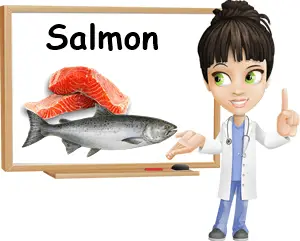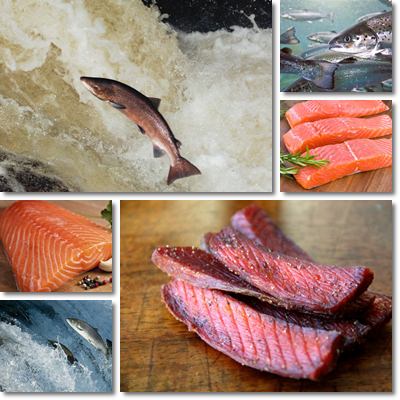Salmon is one of the top choices of healthy fish and a source of wonderful health benefits. Rich in Omega-3 fatty acids, salmon provides cardiovascular benefits and is a top brain food. Its high vitamin D content makes it a great food for a strong immune system. Eating salmon ensures a generous intake of vitamins and minerals that support bone health and help prevent osteoporosis, promote muscle growth and repair, boost energy levels and fertility, improve eyesight, regulate mood, appetite and sleep.
Where does salmon live? Adult salmon species lay their eggs in freshwater. When the young fish reach a certain maturity, they migrate to the ocean where they live for several years until they are ready to lay their eggs. All salmon return to freshwater, often to their birth place, when the time comes to reproduce and most die shortly after this. Very few survive to repeat the cycle. Salmon may live anywhere from 2 to 8 years. Some species never migrate to the ocean and only live in freshwater.

Where does salmon get its color from? Salmon is probably best known for its red-orange color which is a result of carotenoids, natural pigments present in the flesh of the fish. Astaxanthin and canthaxanthin are the two carotenoids that give salmon fish their spectacular color. Salmon species get these carotenoids from smaller marine life they eat, like krill, small algae, plankton or shrimp. Asthxantin is fed to farmed salmon to give its meat the characteristic red-orange color. Salmon with white flesh also exists and the lack of pigment is a result of dietary particularities such as the lack of food availability.
Wild salmon vs. farmed salmon
There is great debate as to which is better: wild salmon or farmed salmon? The truth is there are benefits to both as well as disadvantages. For example, wild salmon may contain more Omega-3 because some fish farms may feed their salmon vegetable protein to reduce production costs. And wild salmon gets its Omega-3 from smaller seafood it consumes. At the same time, wild salmon can potentially be infested with Anisakis parasites that can cause intestinal blockages and allergic reactions in humans. Farmed salmon is generally not a carrier of this intestinal parasite.
Farmed salmon may contain toxic pollutants which can accumulate in humans and causes serious health problems over time, like fertility problems, birth defects, endocrine imbalances, thyroid problems, cancers etc. Wild salmon may contain higher levels of mercury if the waters where it is caught from are polluted, although it is generally a safe fish to eat. Overall, both wild and farmed salmon are good choices, with wild salmon having more benefits due to it living in natural conditions that allow it to enjoy the best possible diet.

What are the benefits of salmon?
As a food fish, salmon provides the following health benefits:
1) Source of Omega-3 fatty acids. Salmon is best known for being an excellent source of healthy fats, notably Omega-3 fatty acids. Depending on the variety and whether it’s farmed or wild caught, 85 g (3 oz) of salmon can typically have anywhere between 1.1 g-1.9 g of a form of Omega-3 called DHA. This particular form of the fatty acid has been found to be part of the composition of gray matter and cell membranes of nervous system cells.
2) Great Omega 3-Omega 6 ratio. The ratio of Omega-3 to Omega-6 refers to how much Omega-3 salmon has compared to Omega-6. Raw wild salmon has a 12:1 Omega 3 to Omega-6 ratio, while canned salmon 11:1. This basically makes salmon a great option for meeting our nutritional demands of healthy fats. And although Omega-6 is maybe just as important for a maintaining a healthy balance in our diets, it’s a fatty acid we can easily get from nuts, seeds, vegetable oils, whereas Omega-3 is scarce.
It has been theorized that an unbalanced intake of fatty acids of the likes of a 25:1 Omega-6-Omega-3 ratio is the culprit for the onset of numerous modern diseases. A 1:4 or 1:3 Omega-6 to Omega-3 ratio is believed to be ideal for good health. On the same note, mackerel has a 1:11 Omega-6 to Omega-3 ratio (read more about the benefits of mackerel). Canned tuna (in water and in oil) has a 1:30 respectively 1:15 ratio of Omega-6 to Omega-3 ratio.
3) Source of cholesterol. Cholesterol is not at all an agent of cardiovascular disease, but actually a nutrient in its own right. Cholesterol helps make up the myelin sheath, a sort of coating that protects the tail of neurons and helps them better communicate with each other. When demyelination occurs, neurons lose their protective coating which leaves them unable to properly conduct electrical impulses from the brain to the rest of the body and vice versa. Demyelination is the causative agent of diseases such as multiple sclerosis, which is why meeting our nutritional demands of cholesterol is important. Other nutrients like vitamin B12 also protect nerve cells and prevent damage to the myelin sheath.
Other benefits of cholesterol in salmon include synthesis of vitamin D, vital for a strong immune system and strong, healthy bones and improved digestion. Moreover, as a result of its role in hormone production, cholesterol is an important nutrient for fertility, making salmon a great food for fertility.
Salmon may contain anywhere from 55 to 155 mg of cholesterol per 100 g. While there is no upper limit to how much cholesterol you can eat, it is recommended to keep your intake low, usually below 300 mg a day, because many foods that contain cholesterol (like meat) also have high amounts of unhealthy saturated fats.
4) Source of protein. On average, 85 g (3 oz) of salmon provides a little over 19 g of protein, making salmon a great source of quality protein that contains all essential amino acids required to keep us alive and in good health. In addition to building and maintaining muscle mass and repairing damaged muscle, amino acids in protein help synthesize neurotransmitters in the brain. Neurotransmitters are what regulates most functions in the body such as appetite, mood and sleep and the basis of nervous system health.
5) Rich in B vitamins. Salmon contains generous amounts of vitamins B1, B2, B3, B6, B9 and B12, vital for a good energy metabolism and brain and nervous system health. For example, vitamin B12 helps preserve the integrity of nerve cells, preventing them from losing their protective myelin coating and reducing the risk for diseases like multiple sclerosis. Vitamin B9 contributes to brain development of babies in the womb and protects against neural tube defects in newborns (birth defects of the brain, spine and spinal cord).
6) High vitamin D content. Because it’s an oily fish, salmon is rich in fat-soluble vitamins like vitamins A and D. It has a particularly high content of vitamin D, as a result of which it provides benefits such as better immunity, strong bones, reduced risk of osteoporosis and chronic diseases. Vitamin A also plays an important part in the immune system response and has benefits for eyesight and skin.
7) Great source of phosphorus, potassium, magnesium and zinc. Vitamin D together with phosphorus and magnesium in salmon regulate calcium absorption and encourage the production of new bone, ensuring good bone density and protecting against osteopenia and osteoporosis. Zinc and vitamins A and D in salmon support good immunity. Potassium together with Omega-3 fatty acids provide cardiovascular benefits.
8) Low mercury load. Salmon is classified as a low risk fish meaning it typically has low mercury levels and is thus safe to eat in moderate amounts. This is actually one the properties that recommends it during pregnancy, as a substitute for tuna, for example. It is recommended to eat up to two servings of fish or seafood per week.
Potential side effects
Toxins in salmon. Farmed salmon may contain varying levels of certain pollutants with detrimental effects on human health. However, experts believe the amounts are too low to produce adverse health effects from the consumption of the fish meat alone.
Salmon and intestinal parasites. Salmon is a potential carrier of intestinal parasites, notably Anisakis, a type of parasite that can form cysts in the human digestive system that could create intestinal blockages. Because this type of parasite alerts the immune system, the reactions that follow can potentially trigger severe allergic responses such as anaphylaxis. Wild salmon is the main carrier of Anisakis parasites because it lives its adult life in an uncontrolled environment in waters with high salinity where the parasite flourishes.
